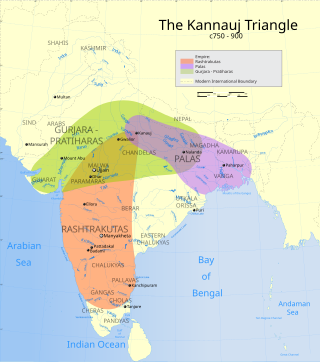Related Research Articles
The Pāla Empire was an imperial power during the post-classical period in the Indian subcontinent, which originated in the region of Bengal. It is named after its ruling dynasty, whose rulers bore names ending with the suffix Pāla. The empire was founded with the election of Gopāla as the emperor of Gauda in late eighth century AD. The Pala stronghold was located in Bengal and eastern Bihar, which included the major cities of Gauḍa, Vikramapura, Pāṭaliputra, Monghyr, Somapura, Ramavati (Varendra), Tāmralipta and Jaggadala.

The Sena dynasty was a Hindu dynasty during the early medieval period on the Indian subcontinent, that ruled from Bengal through the 11th and 12th centuries. The empire at its peak covered much of the north-eastern region of the Indian subcontinent. The rulers of the Sena Dynasty traced their origin to the south Indian region of Karnataka.

The Pala dynasty of Kamarupa kingdom ruled from 900 CE. Like the Pala Empire of Bengal, the first ruler in this dynasty was elected, which probably explains the name of this dynasty "Pala". But unlike the Palas of Bengal, who were Buddhists, the Palas of Kamarupa were Hindus. The Hindu orthodoxy drew their lineage from the earlier Varman dynasty and thus ultimately from Narakasura i.e. Bhauma dynasty. The dynasty is unrelated to the previous Varman and Mlecchna dynasty.

The Kamboja-Pala dynasty ruled parts of Bengal in the 10th to 11th centuries CE, after invading the Palas during the reign of Gopala II. The last Kamboja ruler of the Kamboja-Pala Dynasty Dharmapala was defeated by the south Indian Emperor Rajendra Chola I of the Chola dynasty in the 11th century.

Bikrampur was a pargana situated 19 kilometres (12 mi) south of Dhaka, the modern capital city of Bangladesh. In the present day, it is known as Munshiganj District of Bangladesh. It is a historic region in Bengal and was a part of the Bhawal Estate.
Gopala was the founder of the Pala dynasty of Bihar and Bengal regions of the Indian Subcontinent. The last morpheme of his name Pala means "protector" and was used as an ending for the names of all the Pala monarchs. Pala does not suggest or indicate any ethnic or caste considerations of the Pala dynasty. He came to power in later half of eighth century AD in Gaur/Gaud after being elected by a group of regional chieftains.

Dharmapala was the second ruler of the Pala Empire of Bengal region in the Indian subcontinent. He was the son and successor of Gopala, the founder of the Pala Dynasty. He greatly expanded the boundaries of the empire, and made the Palas a dominant power in the northern and eastern India.
Vigrahapala II was the successor to the Pala king Gopala III in the Bengal region of the Indian subcontinent, and tenth ruler of the Pala line reigning for at least 12 years. He was succeeded by the famed Mahipala.
Vigrahapala III was the successor to the Pala king Nayapala in the Bengal region of the Indian subcontinent, and twelfth ruler of the Pala line reigning for 15 years. He was succeeded by Mahipala II.
Mahipala II was the successor to the Pala king Vigrahapala III in the Bengal region of the Indian subcontinent, and thirteenth ruler of the Pala line reigning for 6 years. He was succeeded by Shurapala II.
Shurapala II was a ruler of the Pala Empire in the Eastern regions of the Indian subcontinent. He was the successor to the Pala king Mahipala II and fourteenth ruler of the Pala line, reigning for at least two years.
Ramapala was the successor to the Pala king Shurapala II in the Bengal region of the Indian subcontinent, and fifteenth ruler of the Pala line.
Gopala IV, previously called Gopala III, was the successor and son to the Pala king Kumarapala in the Bengal region of the Indian subcontinent, and nineteenth ruler of the Pala line reigning for at least 15 years, proved by a manuscript currently at British library.
Madanapala was the successor to the Pala king Gopala IV in the Bengal region of the Indian subcontinent, and eighteenth and final ruler of Pala lineage reigning for 18 years. He was succeeded by Govindapala, whose lineage of that name is questionable.
Kalyanachandra was the third ruler of the Chandra dynasty in eastern Bengal. His campaign against the Kamboja dynasty of northern Bengal allowed the resurgent Pala Emperor Mahipala I to reclaim much of the Pala Empire. He was also the father of Buddhist patron Atiśa.
Hemanta Sena, the founder of the Hindu Sena dynasty in the Bengal region of the Indian subcontinent.
Vijaya Sena, also known as Vijay Sen in vernacular literature, was the son of Hemanta Sena, and succeeded him as a Sena dynasty ruler of Bengal region of the Indian subcontinent. This dynasty ruled for more than 200 years. He conquered Bengal, fighting the kings of Gauda, Kamarupa, and Kalinga. He had a capital in Vijayapuri and Vikramapura.

Deva Dynasty was a Bengali Hindu dynasty which originated in the Bengal region of the Indian subcontinent; the dynasty ruled over eastern Bengal after the Sena dynasty. The capital of the dynasty was Bikrampur in present-day Munshiganj District of Bangladesh.
Gopala III, previously known as Gopala II, was the successor to the Pala king Rajyapala in the Bengal region of the Indian subcontinent, and ninth ruler of the Pala line reigning for 20 years. He was succeeded by Vigrahapala II.
References
- ↑ Bhuiyan, Muhammad Masudur Rahman (2012). "Pala Dynasty". In Islam, Sirajul; Jamal, Ahmed A. (eds.). Banglapedia: National Encyclopedia of Bangladesh (Second ed.). Asiatic Society of Bangladesh.
- Sircar, D. C. The Bhauma-Naraka or the Pala Dynasty of Brahmapala, The Comprehensive History of Assam, ed H. K. Barpujari, Guwahati, 1990.